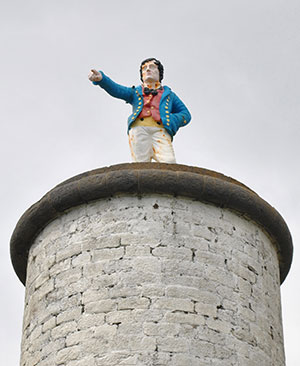Metal Man Tower
Published in Gems of Architecture, Issue 6 (November/December 2017), Volume 25Westtown, Co. Waterford
By Brendan Wright
Tragedy at sea in the early nineteenth century brought about a defining feature of the County Waterford coastline. On the morning of 30 January 1816, HMS Sea Horse, carrying members of the 2nd Battalion, 59th (2nd Nottinghamshire) Regiment of Foot, hit a storm as she sailed from Ramsgate to Cork. She ran aground on a shoal off Tramore Bay, foundered and rapidly broke up. Only 30 of the souls on board survived, and 292 men with 71 women and children were lost. Many who managed to swim the mile to shore succumbed to hypothermia. HMS Sea Horse was part of a convoy of three vessels, and the other ships, SV Boadicea and SV Lord Melville, were also wrecked, with the loss of over 200 lives.
Above: The three beacons on Great Newton Head on the westerly side of Tramore Bay, Co. Waterford, and (inset) a close-up of the ‘Metal Man’. (Brendan Wright)
Insurers Lloyds of London were appalled and, aware that the entrances to Tramore Bay and Waterford Harbour were easily confused, commissioned and funded five beacons on the headlands flanking Tramore Bay—three on the westerly Great Newtown Head and two on the easterly Brownstown Head. Each circular-plan beacon is constructed of finely dressed stone, gently tapering to the top and finished with a beaded cap. The brilliant white limewash finish was designed to dazzle in sunlight and to glow in moonlight, warning seafarers of the hazards ahead.
The design of the beacons has in the past been ascribed to Alexander Nimmo (1783–1832), engineer to the Commissioners of the Irish Fisheries. Recent research by the Commissioners of Irish Lights, however, has identified George Halpin (1779–1854), Inspector of Works and Harbours for the Ballast Board, as a more likely designer. Indeed, the tapering silhouette of each beacon recalls a contemporary Halpin lighthouse without its lantern.
 No such doubt surrounds the identity of the artist responsible for the figure giving the central of the Great Newtown Head beacons its sobriquet ‘Metal Man Tower’. The Cork-born sculptor Thomas Kirk (1781–1845) had a healthy client base in the early nineteenth century; his large-scale works included Dublin’s Nelson’s Pillar (1808). Kirk exhibited a sketch for a ‘Jack Tar’ at the Hibernian Society of Artists, Dublin, in 1815 and a model of the same in London two years later. In 1817 a cast of ‘Jack Tar’ was made by John Clarke at the request of the Ballast Board. The figure, twice life size and pointing to Hook Head and the entrance to Waterford Harbour, wears the uniform of British sailors at the time of the sinking of HMS Sea Horse—a gold-buttoned royal blue coat, bright red waistcoat and white trousers.
No such doubt surrounds the identity of the artist responsible for the figure giving the central of the Great Newtown Head beacons its sobriquet ‘Metal Man Tower’. The Cork-born sculptor Thomas Kirk (1781–1845) had a healthy client base in the early nineteenth century; his large-scale works included Dublin’s Nelson’s Pillar (1808). Kirk exhibited a sketch for a ‘Jack Tar’ at the Hibernian Society of Artists, Dublin, in 1815 and a model of the same in London two years later. In 1817 a cast of ‘Jack Tar’ was made by John Clarke at the request of the Ballast Board. The figure, twice life size and pointing to Hook Head and the entrance to Waterford Harbour, wears the uniform of British sailors at the time of the sinking of HMS Sea Horse—a gold-buttoned royal blue coat, bright red waistcoat and white trousers.
Legends have grown up around this curious figure, and it is said that during stormy weather he can be heard calling Keep out! Keep out! Good ships from me, for I am the rock of misery! Early twentieth-century photographs capture a tradition whereby a chain of unmarried ladies would hop three times around the base of the tower in the hope of finding a husband within a year.
In addition to the beacons, the sinking of HMS Sea Horse is remembered by an obelisk-topped monument in the grounds of Christ Church (Drumcannon) in Tramore, a weathered ledger on Doneraile Walk and a ‘cairn’ unveiled on The Promenade on 30 January 2016, the bicentenary of the tragedy. The seahorse was also adopted as the emblem of Tramore Golf Club and Waterford Crystal.
Brendan Wright is a third-year Culture and Heritage honours degree student at IT Carlow, Wexford Campus. Series based on the NIAH’s ‘building of the month’, www.buildingsofireland.com.
















